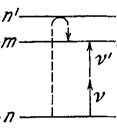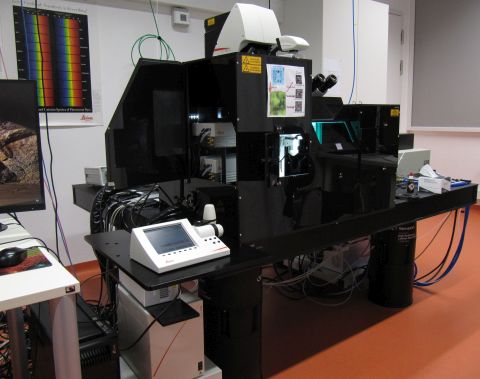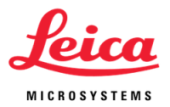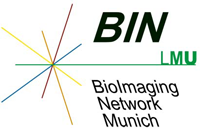Göppert: Multi-photon microscope with excitation up to 1300 nm
 Named after Maria Göppert-Mayer (1906 - 1972), a German-American physicist who predicted the two photon effect in her thesis (Wikipedia de|en).
Named after Maria Göppert-Mayer (1906 - 1972), a German-American physicist who predicted the two photon effect in her thesis (Wikipedia de|en).
Summary
This Leica SP8 MP upright microscope has a DM6 stand with a fixed, stable Scientifica stage. Multi-photon excitation is possible continuously from 680 - 1300 nm. Thanks to additional 488, 562 and 638 nm lasers, this instrument also can double as confocal microscope. A CCD-Camera allows recording of conventional fluorescence.

Introductory movie
Please click here for the introductory movie for our MP microscopes.
Optics
Condenser
P 0.9 S1. The 0.9 indicates the numerical aperture.
Objectives
- The standard objective on this microscope is a HC IRAPO L 25x/1.00 W motCORR. As indicated by the name, this water immersion objective has a motorized correction collar, so that it can be adjusted to minimize spherical aberration at variable depths within the specimen, or to work with or without coverglas. Working distance is 2.6 mm. Transmission is said to be >85% between 470 and 1200 nm. "Superior" color correction from 700 to 1300 nm. This objective is mounted on its own slider (not in a revolver).
- The special HC FLUOTAR L 25x/1.00 IMM motCORR VISIR is optimized for samples cleared with the CLARITY procedure (ne=1.457). It also has a motorized correction collar, works with or without coverglas. Working distance is 6 mm. Transmission > 85% from 470 - 1200 nm. The curve from 400 - 1300 is shown in the Leica Objective Brochure on page 17. Color correction. None for 405 nm excitation, "good" in the visible range and "excellent" >800 nm (but not "superior"). Mounted on its own slider (not in a revolver).
- The following objectives are mounted in a revolver. It can be exchanged against the standard objective by facility personnel.
- HC PL FLUOTAR 5x/0.15, working distance (WD) 12.0 mm. Usable with and without coverslip, no immersion.
- Obj. HC PL IRAPO 40x/1.10 W CORR, WD 0.65 mm, water immersion. For usage with coverslips 0.14 - 0.18
mm at temperatures 20 - 40°C (correction collar must be adjusted accordingly). Optimized for multi-photon excitation, high transmission from 470 - 1300 nm. The full curve is shown in the Leica IR Objective-Flyer. Of all our multi-photon objectives, this is the one with the highest NA. - Obj. HC PL APO 63x/1.40 OIL CS2. WD 0.14 mm, with cover glass and oil immersion. This objective is not recommended for multi-photon, but if the microscope is used as a confocal: Color correction and transmission "superior" in the visible range, but not corrected >800 nm.
Conventional fluorescence
Meant mostly for visual inspection, but documentation is possible with the CCD-Camera. Excitation with SOLA-II white light LED.
Filters
The following filters for conventional fluorescence are available
- green ("I3", exc. 450-490, em. LP 515)
- orange ("N2.1", exc. 515-560, em. LP 590).
CCD-Camera
Leica DFC365FX with Sony ICX285 interline CCD chip. 1392 x 1040 pixels, Chip pixel size 6.45μm. 12 bit, 4096 graylevels. Leica Website on the DFC365FX with pdf downloads.
Confocal Light Path
One-photon-Excitation Lasers
- Solid state laser Blue, 488±2 nm, 20 mW output.
- Solid state laser green, 552±2 nm, 20 mW output.
- Solid state laser red, 638±2 nm, 30 mW output.
Beam Splitter
"LIAchroic" beam splitters with low incident angle to improve transmission are used. The following are available:
- Neutral beam splitter, ratio 15/85.
- LIAchroic beam splitter for 405 / 488 / 552 nm excitation.
- LIAchroic beam splitter for 405 / 488 / 552 / 638 nm excitation.
(Note 405 excitation is not available on this system, see excitation lasers above.)
Depending on the selected excitation wavelengths, the settings for this filters are made automatically.
Descanned, internal detectors in the spectral scan head
The descanned detectors for the confocal images are all behind the pinhole in the spectral scan head which allows continuous detection between 400 and 800 nm. The spectral scan head contains 3 Photomultiplier Tubes (PMTs; Hamamatsu R 9624).
Multi-photon light path
Multi-photon excitation laser
InSight DS+ Single from Spectra Physics (product website). Emission tunable from 680 - 1300nm. Automatic dispersion precompensation. Output >1.2 W at 900nm, pulse width <120 fs.
Detectors
Four backward non-descanned, "external" detectors for multi-photon microscopy are available. In addtion to those dedicated multi-photon detectors, the internal detectors (see above) can be used with opened pinhole. While they will generally collect less light than the external ones, they may be favorable for very bright signals or for spectral windows which cannot be covered with filters for external detectors.
Backward external detectors
The backward detectors are hybrid photodetectors. Light to the lower (HyD 1 & 2; green-blue) and upper deck (HyD 3 &4; red) is split by a main beam splitter separating at either 560 or 605 nm. Each deck protects the detectors with a blocking filter to suppress multi-photon excitation light (SP 800 for the upper deck). Within each deck a filter block contains a secondary beam splitter and two excitation filters.
Caution: The HyDs are very sensitive (45% QE at 530 nm) but also easily damaged! As explained during hands-on training, if you have an untested sample we highly recommend to start low excitation powers to get an impression of signal intensity. See "Sensors for True Confocal Scanning" (Leica Science Lab) for more infos on HyDs. If signals should be too bright, you also can use the internal PMTs in the spectral detector. If so, remember to open the pinhole to maximum.
The following filter blocks are available:
| Name | Bandpass for channel 2/4 | Beam Splitter | Bandpass for channel 1/3 | which deck? |
|---|---|---|---|---|
| *AHF | HC 405/150 (blue) |
BS 488LPXR | ET 525/50 (green) |
lower |
| CFP/YFP | BP 483/32 (cyan) |
BS 505 | BP 535/30 (yellow) |
lower |
| FITC TRITC | BP 525/50 (green) |
BS 560 | BP 585/40 (orange) |
lower (only with main splitter 605) |
| *TRITC-A633 | BP 585/40 (orange) |
RSP 620 | BP 650/50 (far red) |
upper (only with main splitter 560) |
| mCherry-Cy5 | BP 624/40 (near red) |
RSP 650 | BP 685/40 (far far red) |
upper |
Cubes with * are the standard configuration. If you need other cubes, please contact the core facility staff.
Scanners
Two different scan modes are available. The "normal" scanner has a very large maximal field of view with up to 8192x8192 pixels and speeds between 1-1800 lines per second (Hz). With 512x512 pixels it can record up to 7 frames per second. Zoom factor can be 0.75 - 48x.
The 8 kHz resonant scanner does a fixed number of 8000 lines per second, or 16000 in bidirectional mode. It records up to 28 frames at 512x512 pixels. Maximal image size is 1248x1248 pixels, zoom factor 1,3x - 48x.
Stage
The Scientifica MMBP stage of the microscope is fixed, meaning it cannot be automatically moved up and down. (The objective is moved up and down to make z-stacks.) Its advantage is that it can carry heavy loads, according to the spec sheet up to 30 kg. MMBP stands for Motorised Moveable Base Plate. It can be moved in x,y with a step size of 0.1 µm over 50 mm via the software or via external control.
For your Methods Section
If you used this microscope in your work, here is a suggestion for your methods section. You are welcome to copy it, but make sure to adapt it to the objectives, pixel size, dyes, filter settings etc. that you actually used.
"Multi-photon microscopy was performed at the core facility bioimaging of the Biomedical Center with a Leica SP8 MP microscope, equipped with a pulsed InSight DS+ laser. Excitation of all dyes was with 860 nm. The following bandpass filters were used for detection: GFP: 525/50, Cy3: 585/40. Confocal images were recorded on the same machine using solid state laser excitation at 488, 552, and 638 nm. Images were acquired with a 20x1.0 objective, image pixel size was 200 nm. Multi-photon excited images were recorded with external, non-descanned hybrid photo detectors (HyDs), confocal images with internal conventional photomultiplier tubes."
You are very welcome to ask the facility staff for help to get your microscopy section right. Acknowledgement of the core facility is extremely important for us justify past funding and thus to secure future funding, so that we will be able to continue to provide good services to you.







